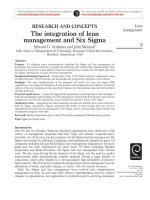The architecture of computer hardware and systems software an information technology approach ch10
Bạn đang xem bản rút gọn của tài liệu. Xem và tải ngay bản đầy đủ của tài liệu tại đây (4.47 MB, 35 trang )
Chapter 10
Computer Peripherals
The Architecture of Computer Hardware
and Systems Software:
An Information Technology Approach
3rd Edition, Irv Englander
John Wiley and Sons
2003
Peripherals
Devices that are separate from the
basic computer
Not the CPU, memory, power supply
Classified as input, output, and storage
Connect via
Ports
parallel, USB, serial
Interface to systems bus
SCSI, IDE, PCMCIA
Chapter 10
10-2
Storage Devices
Primary memory
Expanded storage
Secondary storage
Data and programs must be copied to
primary memory for CPU access
Permanence of data
Direct access storage devices (DASDs)
Online storage
Offline storage – loaded when needed
Chapter 10
10-3
Speed
Measured by access time and data
transfer rate
Access time: average time it takes a
computer to locate data and read it
millisecond = one-thousandth of a second
Data transfer rate: amount of data that
moves per second
Chapter 10
10-4
Hierarchy of Storage
Device
Typical Access Times
Throughput Rate
CPU Registers
Cache Memory (SRAM)
15 to 30 nanoseconds
Conventional Memory (DRAM)
50 to 100 nanoseconds
Expanded Storage (RAM)
75 to 500 nanoseconds
Hard Disk Drive
Floppy Disk
CD-ROM
Tape
Chapter 10
10 to 50 milliseconds
95 milliseconds
100 to 600 milliseconds
.5 and up seconds
600 to 6,000 KB/sec
100 to 200 KB/sec
500 to 4,000 KB/sec
2,000 KB/sec (cartridge)
10-5
Secondary Storage Devices
Hard drives, floppy drives
CD-ROM and DVD-ROM drives
CD-R, CD-RW, DVD-RAM, DVD-RW
Tape drives
Network drives
Direct access vs. Sequential access
Rotation vs. Linear
Chapter 10
10-6
Magnetic Disks
Track – circle
Cylinder – same track on all platters
Block – small arc of a track
Sector – pie-shaped part of a platter
Head – reads data off the disk
Head crash
Parked heads
Number of bits on each track is the same! Denser towards the
center.
CAV – constant angular velocity
Spins the same speed for every track
Hard drives – 3600 rpm – 7200 rpm
Floppy drives – 360 rpm
Chapter 10
10-7
A Hard Disk Layout
Chapter 10
10-8
Locating a Block of Data
Average seek time: time required
to move from one track to
another
Latency: time required for disk to
rotate to beginning of correct
sector
Transfer time: time required to
transfer a block of data to the
disk controller buffer
Chapter 10
10-9
Disk Access Times
Avg. Seek time
average time to move from one track to another
Avg. Latency time
average time to rotate to the beginning of the
sector
Avg. Latency time = ½ * 1/rotational speed
Transfer time
1/(# of sectors * rotational speed)
Total Time to access a disk block
Avg. seek time + avg. latency time + avg. transfer time
Chapter 10
10-10
Magnetic Disks
Data Block Format
Interblock gap
Header
Data
Formatting disk
Disk Interleaving
Disk Interleaving
Disk Arrays
RAID – mirrored, striped
Majority logic fault-tolerant computers
Chapter 10
10-11
Disk Block Formats
Single Data Block
Header for Windows disk
Chapter 10
10-12
Alternate Disk Technologies
Removable hard drives
Disk pack – disk platters are stored in a plastic case that is
removable
Another version includes the disk head and arm assembly in
the case
Fixed-head disk drives
One head per track
Eliminates the seek time
Bernoulli Disk Drives
Hybrid approach that incorporates both floppy and hard disk
technology
Zip drives
Chapter 10
10-13
Magnetic Tape
Offline storage
Archival purposes
Disaster recovery
Tape Cartridges
20 – 144 tracks (side by side)
Read serially (tape backs up)
QIC – quarter inch cartridge (larger size)
DAT – digital audio tape (small size)
Size typically includes (2:1 compression)
Chapter 10
10-14
Optical Storage
Reflected light off a mirrored or pitted surface
CD-ROM
Spiral 3 miles long, containing 15 billion bits!
CLV – all blocks are same physical length
Block – 2352 bytes
2k of data (2048 bytes)
16 bytes for header (12 start, 4 id)
288 bytes for advanced error control
DVD-ROM
4.7G per layer
Max 2 layers per side, 2 sides = 17G
Chapter 10
10-15
Optical Storage
Laser strikes land: light reflected into detector
Laser strikes a pit: light scattered
Chapter 10
10-16
Layout: CD-ROM vs. Standard Disk
CD-ROM
Chapter 10
Hard Disk
10-17
CD-ROMs
General Speed
Seek Time
(milliseconds)
Single-Speed
600
150K per second
2X
320
300K per second
3X
250
450K per second
4X
135-180
600K per second
6X
135-180
900K per second
8X
135-180
1.2 MBps
10X
135-180
1.6 MBps
12X
100-150
1.8 MBps
16X
100-150
2.4 MBps (maximum)
24X
100-150
3.6 Mbps (maximum)
32X
100-150
4.8 Mbps (maximum)
Chapter 10
Data Transfer Rate
10-18
Types of Optical Storage
WORM Disks
Write-once-read-many times
Medium can be altered by using a medium-powered laser to
blister the surface
Data stored in concentric tracks, sectored like a magnetic
disk
CAV
Medium-powered laser blister technology also used
for
CD-R, DVD-R, DVD-ROM
CD-RW, DVD-RW, DVD-RAM, DVD+RAM
Magneto-Optical Disks
Chapter 10
10-19
Displays
Pixel – picture element
Size: diagonal length of screen
Resolution (pixels on screen)
VGA: 480 x 640
SVGA: 600 x 800
768 x 1024
1280 x 1024
Picture size calculation
Resolution * bits required to represent number of colors
in picture
Example: 16 color image, 100 pixels by 50 pixels
4 bits (16 colors) * 100 * 50 = 20,000 bits
Chapter 10
10-20
Display Screen
Screen size: measured
diagonally
Resolution: minimum
identifiable pixel size
Aspect ratio: x pixels to
y pixels
4:3 on most PCs
16:9 on high definition
displays
Chapter 10
10-21
Color and Displays
Pixel color is determined by intensity of
3 colors – Red Green Blue or RGB
4 bits per color
16 x 16 x 16 = 4096 colors
24 bit color (True Color)
16.7 million colors
Video memory requirements are
significant!
Chapter 10
10-22
CRT’s and Text Monitors
CRTs (similar to TVs)
3 stripes of phosphors for each color
3 separate electron guns for each color
Strength of beam brightness of color
Raster scan
30x per second
Interlaced vs. non-interlaced (progressive scan)
Text monitors
24 lines x 80 chars
A character is the smallest unit on a screen
Very little memory required
Fast for remote transmissions
Chapter 10
10-23
Interlaced vs Noninterlaced
Chapter 10
10-24
Diagram of Raster Screen
Generation Process
Chapter 10
10-25









